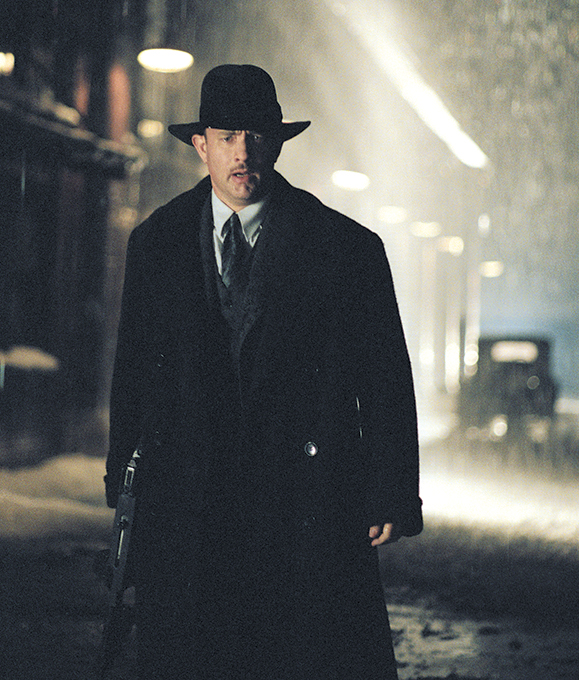The legendary B-movie writer-director Samuel Fuller once told me about a script he had written called The Bag Man. The title character is a bag man for the mob, a functionary whose job is to deliver packages but never to look inside them. One day he makes the fatal mistake of looking inside. He takes the money and runs.
Explaining the real novelty of his story, Fuller said with mounting excitement, “You’ve seen movies about a man on the run. You’ve seen movies about a man and a woman on the run. But you haven’t seen a movie about a man and a woman and a KID on the run!”
Road to Perdition, based on a graphic novel written by Max Allan Collins and illustrated by Richard Piers Rayner, resembles The Bag Man, though it’s far less exciting than the film Fuller would have made. Tom Hanks is cast against type as Michael Sullivan, a hit man for the Irish-American mob in Depression-era Rock Island, Illinois. When his 12-year-old son, Michael, Jr. (Tyler Hoechlin), witnesses one of the hits, they have to go on the lam together. But they do so without the woman in this story, Mrs. Sullivan, played by Jennifer Jason Leigh.
To tell the truth, I was relieved when Annie Sullivan (no miracle worker, this one) gets knocked off so early in the movie, because that means Jennifer Jason Leigh doesn’t have a chance to do her usual goofily neurotic overacting. Having Mike Sullivan and his kid forge a deeper relationship while leading a life of crime together stirs some disturbingly conflicted feelings, although Road to Perdition is so low-key it keeps the characters and their emotions muted.
Expressing emotion is one of the taboos that govern the lives of the characters in Perdition. One would think that Irish-Americans who live by violence might be a little more outgoing than these morose and taciturn characters. Writer David Self and director Sam Mendes admirably avoid ethnic stereotyping of both Irish and Italian mobsters – Capone underboss Frank Nitti is played with crisp efficiency and no ethnic mannerisms by Stanley Tucci – but perhaps the filmmakers have erred too far in that direction, helping drain the film of color and vitality. Mario Puzo said that while writing The Godfather he had in mind the Kennedy family and the corrupt origins of Old Joe’s fortune in mob-connected bootlegging. The story Puzo tells is that of a young man named Michael Corleone trying to “go straight” and make his immigrant family “respectable.” It was Francis Ford Coppola’s genius in making the Godfather movies that he was able to clearly dramatize the symbiosis between organized crime and what passes for “legitimate” big business in America. We’ve seen in the current wave of corporate scandals that any separation between big business and organized crime is mostly semantic. Woody Guthrie’s 1930s aphorism puts it best: “Some men rob you with a sixgun and some with a fountain pen.”
In Road to Perdition, the wheezy old gang boss played by Paul Newman, John Rooney, will remind you of both Joe Kennedy and Marlon Brando’s Don Vito Corleone. Newman has just a touch of an Irish brogue, never overstressed, to show that he is a relative newcomer to America and will never be able to shake off the curse of criminality that goes with his outsider status.
Through Mike Sullivan’s need to give his family a comfortable middle-class life, we understand why these Irish immigrants found crime the only way to rise from the streets. But the bargain Mike has struck with his father figure, Rooney, is a Faustian pact that ensures their moral damnation.
The question the movie raises is how far the curse extends, and whether it will consume the younger Michael Sullivan as it does his father. Since this is a contemporary Hollywood movie, you know the kid has to escape it somehow – evil and ambiguity may rule the society we live in, but it can’t be allowed to triumph in our mass entertainment. So the suspense comes from finding out how the boy manages to escape.
Visually, the shadowy and largely monochromatic Road to Perdition strongly evokes the first two Godfather movies, which were shot by the cameraman known to his colleagues as “The Prince of Darkness,” Gordon Willis. Perdition was photographed in similarly crepuscular fashion by another modern master, Conrad L. Hall, who has exhibited a wide palette, not always this noirish, in such films as In Cold Blood, Butch Cassidy and the Sundance Kid, Searching for Bobby Fischer, and Mendes’s Oscar-laden American Beauty.
The fancy press kit Dream Works and Twentieth Century Fox sent out for Perdition gave me dread about seeing the movie. The stills are beautifully lit but in a chilly way that calls attention to their artistry and at the same time seems to threaten the puritanical denial of sensual pleasure. But the movie, if stylized to the point of abstraction, has more life than the stills. It’s a tour de force by Hall, and there is a constant dramatic tension between what little we are permitted to see and what is hidden in the shadows.
It’s somewhat surprising that such a dark, lugubrious movie has become a box-office hit. Certainly this is a tribute to the likeability of Tom Hanks, our contemporary equivalent of Jimmy Stewart. The film leans heavily on Hanks’s appeal to convince us that Mike Sullivan has a heart somewhere buried under his killer’s glower. But there’s not much real evidence of a heart, other than in his perpetually guilty, hangdog expression.
His fatherly feeling for young Michael has to be taken largely on faith. The actions Mike takes are selfishly revengeful and rarely take his son’s safety or future well-being into account. The boy’s love for his father despite his murderous nature seems willed rather than deserved, as does the “happy” ending with its invocation of the national myth of bucolic innocence.
Perhaps the movie strikes a chord with today’s mass audience because it tunes in to the deep-seated repression and denial that still govern so much of American life. The pressure placed upon the populace to believe that the emperor is clothed, our guilty awareness of the senseless violence being perpetrated in our name in shadowy corners of the world, our dread of unfettered sexuality – all this is well captured in the bleak world of Mike Sullivan.
By setting the movie in 1931, in the depths of the Great Depression, the movie seems to be reassuring us that all this shame is in the past, that we’ve grown beyond it, that young Michael probably grew up OK. But part of us knows full well that the pervasive culture of violence the film portrays as the price of success in America has only grown more intense, and that someone who’s seen what Michael has seen has little chance of growing up OK. ♦




Leave a Reply